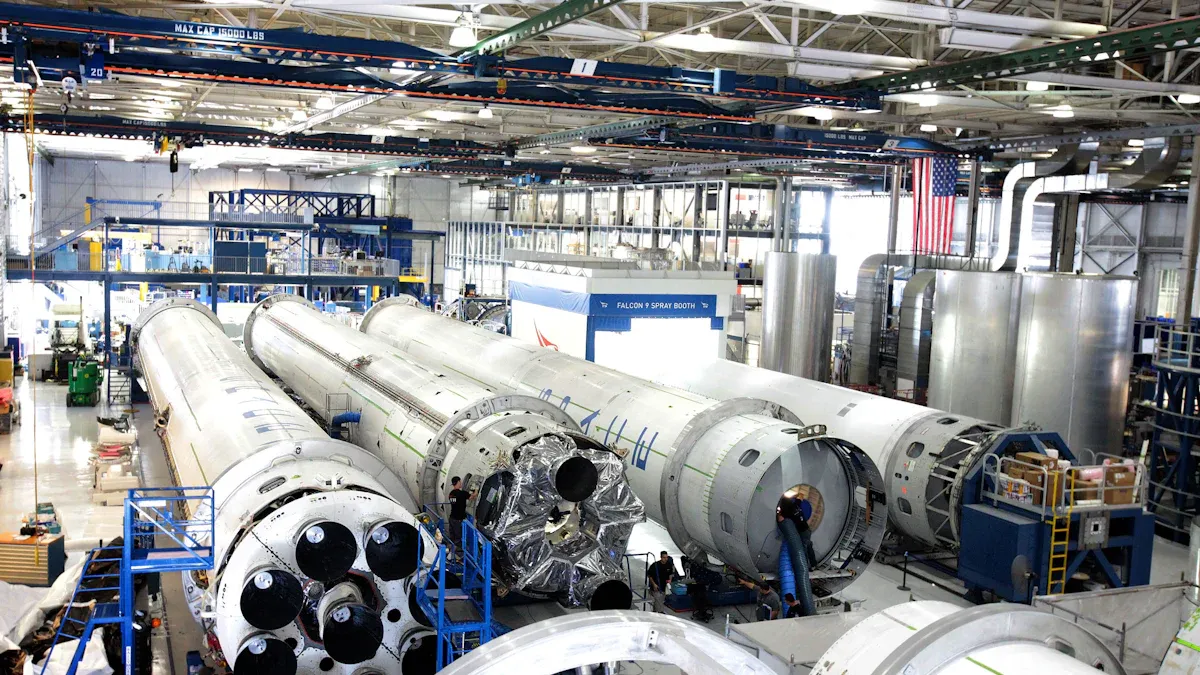You use powder cores in big machines because they work well and save energy. They do not waste much power and do not get too hot. This helps you stop problems like losing energy and too much heat. The special air gap design lets you handle both slow and fast jobs easily. Powder cores are better than other materials. They help you when you need strong and steady parts in tough places.
Powder cores save energy and help machines stay cool. This makes them great for use in factories and other industries. They keep their inductance steady even when it gets hot. This helps them work well in hard situations. Powder cores can handle a lot of current without problems. They stop energy from being lost all at once. This is very important for things like solar inverters. These cores can be used in many ways. They work in power supplies, inverters, and noise filters. Using powder cores can help machines last longer. They also help lower energy bills. This makes them a good choice for new projects.

Industrial systems need inductance that does not change much. Powder cores keep inductance steady, even when it gets hot, up to 200°C. The air gap inside helps stop big changes in inductance. You will only see a small change, just a few percent, if the temperature or frequency goes up. This means your machines work well and do not lose power fast.
Tip: Using powder cores gives you better results than many other core materials. For example, powdered iron cores keep inductance steady and handle more power than ferrite cores. This makes them a good pick for hard industrial jobs.
|
Core Type |
Inductance Stability |
Saturation Levels |
Temperature Stability |
Current Handling Capability |
|---|---|---|---|---|
|
Powdered Iron |
High |
High |
Moderate |
High |
|
Ferrite |
Moderate |
Low |
High |
Low |
Many machines need to run with high currents. Powder cores are good for this because they have high saturation flux density. Some can reach up to 14,000 Gauss. When DC current goes up, permeability drops slowly and smoothly. This is called "soft saturation." It helps you make circuits that stay safe and work well, even if the current changes a lot. Unlike ferrite cores, powder cores do not lose energy storage suddenly when current is high. This makes them great for UPS systems and solar inverters.
You can use powder cores in:
Electric vehicle charging stations
On-board chargers
DC-DC converters
Solar inverters
Uninterruptible power supplies (UPS)
Industrial switch mode power supplies (SMPS)
Telecom and server SMPS
Power systems need to store and give out energy smoothly. Powder cores help because they store a lot of energy. They keep inductance steady, even if temperature or load changes. The soft saturation curve lets you use a smaller core and still get good performance. This means you can make small, strong systems that handle heavy loads. Powder cores also fight problems like fringing, which wastes energy in other materials.
|
Feature |
Powder Cores |
Ferrite and Silicon Steel |
|---|---|---|
|
Energy Storage Capacity |
High |
Moderate |
|
Inductance Stability |
Maintains stable inductance |
Varies under different conditions |
|
DC Bias Characteristics |
Superior |
Inferior |
|
Susceptibility to Fringing |
Not susceptible |
Susceptible |
|
Bsat Levels |
Higher inherent Bsat levels |
Lower inherent Bsat levels |
Note: Powder cores help you design for high efficiency and fault tolerance. You get steady inductance at different loads, which is important for reliable machines.
You want to stop energy loss in your machines. Powder cores help because they have high resistivity and a special structure. The air gap inside lowers core losses, so there is less heat and better efficiency. These cores also have low hysteresis and eddy current losses. The metal and powder inside work together to keep energy from turning into heat. This is very important in power conversion systems, where saving energy matters.
Powder cores offer:
Low hysteresis loss from good grain size
Low eddy current loss from their special structure
High-temperature stability, so they work well in tough places
You can trust powder cores to work well at many frequencies. They help you build machines that stay cool, last longer, and use less energy.
Iron powder cores are used in many machines. They are made from pure iron particles pressed together. These cores can handle strong magnetic fields, up to 14,000 Gauss. This means your equipment does not get saturated easily. Iron powder cores work in cold and hot temperatures, from -65°C to +125°C. You can pick different shapes like toroidal, E-type, U-type, or R-type. This helps you fit them into your design. These cores work with both DC and AC currents. They do not lose efficiency when doing this. You find them in RF transformers, EMI filters, DC chokes, and inductors. They store energy well and keep noise low. This helps your power supply systems work smoothly.
|
Feature |
Description |
|---|---|
|
High Magnetic Flux Density |
Stops saturation when magnetic fields are strong. |
|
Excellent DC Characteristics |
Works with DC and AC together, good for power electronics. |
|
Broad Temperature Range |
Works well from -65°C to +125°C. |
|
Manufacturing Versatility |
Many shapes fit different designs. |
Tip: Iron powder cores work well in tough places. You can count on them for steady energy conversion.
Sendust powder cores are made from iron, silicon, and aluminum. They have almost no magneto restriction. This means your machines make less noise. These cores lose less energy than iron powder cores. Your equipment stays cool and works better. Sendust stores more energy than gapped ferrite cores. It also lowers gap losses and eddy current losses. You use Sendust in PFC circuits, switching regulator inductors, in-line noise filters, pulse transformers, and flyback transformers. They are used in power electronics, cars, renewable energy, and factories. Sendust helps your systems handle high currents and heat. It also cuts down on interference.
MPP stands for molypermalloy powder. These cores use nickel, iron, and molybdenum. They have high resistivity and low hysteresis. They also have low eddy current losses. MPP cores keep inductance steady, even if the temperature changes. You use them in cars, telecom, and factories. MPP powder cores help you use power well and lower losses. They make your machines work better and more reliably. They also help send data faster and improve smart manufacturing.
|
Composition |
Effects on Magnetic Performance |
|---|---|
|
Ni, Fe, Mo |
High resistivity, low losses, great inductance stability |
Note: MPP cores give you great results in hard jobs. You can trust them for saving energy and staying steady.
High flux powder cores use special alloys. They can handle high magnetic flux densities. These cores have higher saturation than ferrite cores. This helps your machines change power more easily. High flux cores lower energy loss and work in small spaces. You use them in switching regulator inductors, in-line noise filters, flyback transformers, and power factor correction circuits. These cores store more magnetic energy in a small space. This is important for new power systems that need lots of energy.
High flux powder cores are used for:
High power jobs
High DC bias and AC bias designs
Energy storage filter inductors
Power factor correction circuits
Pulse transformers
High flux powder cores help your machines work well in hard places. You get steady results when space and energy are important.

Powder cores are used in many power supply systems. These parts help switch-mode power supplies and converters work fast. You get smaller inductors and transformers. This saves space and energy. In data centers, powder cores lower heat and make things work better. Your devices last longer and cost less to use. Transformers with powder cores lose less energy. They also handle heat well. Inductors in power electronics use powder cores to work at high speeds.
You see powder cores in:
Data center power supplies
Industrial switch-mode power supplies
Power converters for telecom and servers
Tip: Powder cores help you build strong and efficient power systems. They work well in hard places.
Inverters change DC power into AC power. Powder cores help these machines run smoothly and save energy. Car makers tested powder cores and found 15% less energy loss. Renewable energy projects use powder cores for high-temperature stability. Electronics companies pick powder cores for better results at high frequencies.
|
Case Study |
Description |
|---|---|
|
Automotive |
15% less energy loss in inverter tests |
|
Renewable Energy |
Reliable for a long time in tough places |
|
Electronics OEM |
Better high-frequency results in switching power supplies |
Noise filters keep machines quiet and safe. Powder cores block unwanted signals and cut interference. You see them in cars and electronics. About 70% of powder cores are used in these products. Powder cores keep systems steady and protect sensitive equipment.
Main uses:
EMI filters in cars and electronics
Industrial noise suppression
Power line filters for factories
Note: Powder cores help you meet strict noise rules. They keep machines working well.
Powder cores are used in solar and wind energy systems. These cores help transformers and power units move energy with less loss. They work well at high frequencies. This is important for connecting to the grid and storing energy. Molypermalloy powder cores help solar and wind systems change power better. As more people use clean energy, powder cores will be needed more.
Powder cores help wind turbines and solar inverters move energy better.
They make inverters and transformers more reliable.
You will see more powder cores used as renewable energy grows.
Tip: If you work with renewable energy, powder cores help you build systems that work well and last long.
You can see that powder cores are important for today’s industry. They work well, store lots of energy, and do not waste much power. This helps you make machines that are strong and last a long time.
More cars and clean energy projects use these parts every year.
Soon, over 40% of factories will use magnetic powder cores to save energy.
Powder cores are good if you want your machines to last.
Picking new materials like these helps your projects do well in the future.
Think about using powder cores in your next project to keep up with new technology.
Powder cores store more energy than ferrite cores. They handle higher currents without problems. Inductance stays steady, even when it gets hot. Ferrite cores can stop working well if current goes up.
Yes, you can use powder cores for high frequencies. They work in both slow and fast circuits. Powder cores have low core losses and high resistivity. This helps your devices stay cool and work well.
Powder cores are in power supplies and inverters. You also find them in noise filters and renewable energy systems. They help machines last longer and use less energy.
Yes! Powder cores block signals you do not want. They lower interference and keep equipment safe. Your devices stay quiet and work better.
Tip: Think about what your project needs. Pick high flux for lots of energy storage. Use Sendust if you want less noise. Try MPP for steady inductance. Iron powder is good for many uses.
By continuing to use the site you agree to our privacy policy Terms and Conditions.